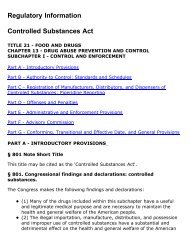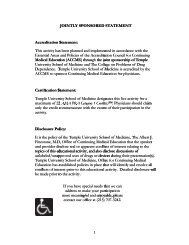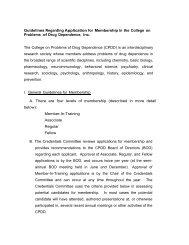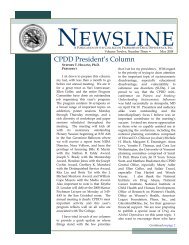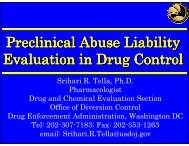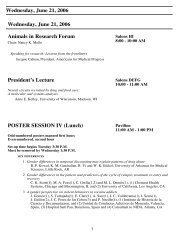CPDD 72nd Annual Meeting • Scottsdale, Arizona - The College on ...
CPDD 72nd Annual Meeting • Scottsdale, Arizona - The College on ...
CPDD 72nd Annual Meeting • Scottsdale, Arizona - The College on ...
Create successful ePaper yourself
Turn your PDF publications into a flip-book with our unique Google optimized e-Paper software.
165<br />
EMPLOYMENT-BASED REINFORCEMENT OF ORAL<br />
NALTREXONE COMPLIANCE WITHIN UNEMPLOYED<br />
INJECTION DRUG USERS.<br />
Kelly E Dunn, A DeFulio, J Everly, W D<strong>on</strong>lin, A Umbricht, M Fingerhood, G<br />
Bigelow, K Silverman; Johns Hopkins University School of Medicine,<br />
Baltimore, MD<br />
Aims: Naltrex<strong>on</strong>e is an opiate antag<strong>on</strong>ist that effectively prevents relapse to opioid<br />
use, however rates of compliance are notoriously poor. Reinforcement of naltrex<strong>on</strong>e<br />
administrati<strong>on</strong> via an employment-based interventi<strong>on</strong> may increase rates<br />
of compliance with oral naltrex<strong>on</strong>e.<br />
Methods: Recently-detoxified participants were randomly assigned to a<br />
Naltrex<strong>on</strong>e C<strong>on</strong>tingency (NC; n=35) or Work Only (WO; n=32) group for a 6m<strong>on</strong>th<br />
period. Participants attended the workplace daily, received access to computer<br />
training and educati<strong>on</strong>al programs, and could earn up to $6,000 in hourly<br />
wages and productivity pay. Urine samples were collected thrice weekly and tested<br />
for evidence of opiates and cocaine. Naltrex<strong>on</strong>e urinalysis testing was c<strong>on</strong>ducted<br />
m<strong>on</strong>thly. Participants in the NC group were required to ingest oral naltrex<strong>on</strong>e<br />
thrice weekly to gain entry into the workplace while WO participants<br />
received a take-home prescripti<strong>on</strong> and could work independently of naltrex<strong>on</strong>e<br />
compliance. Outcome measures are naltrex<strong>on</strong>e, opiate and cocaine urinalysis<br />
results.<br />
Results: At intake, participants were <strong>on</strong> average 45 years old, 61% male, 85%<br />
African-American and had injected heroin and cocaine for 18 and 13 years,<br />
respectively. Data show access to the workplace successfully reinforced compliance<br />
with naltrex<strong>on</strong>e. Mean percent naltrex<strong>on</strong>e-positive urine samples were 83%<br />
and 34% in the NC and WO groups, respectively. Mean opiate-positive samples<br />
were also lower am<strong>on</strong>g NC versus WO participants (18% and 31%, respectively);<br />
however no effect was observed <strong>on</strong> cocaine use (41% vs. 39%, respectively).<br />
C<strong>on</strong>clusi<strong>on</strong>s: This study provides evidence that an employment-based behavioral<br />
treatment can successfully reinforce compliance with naltrex<strong>on</strong>e and help<br />
prevent relapse to opioid abuse. <str<strong>on</strong>g>The</str<strong>on</strong>g> ability to reinforce compliance of a medicati<strong>on</strong><br />
that has a notoriously poor adherence rate in the c<strong>on</strong>text of a workplace<br />
envir<strong>on</strong>ment has important implicati<strong>on</strong>s for disseminati<strong>on</strong> and use with other<br />
low-compliance medicati<strong>on</strong>s.<br />
Financial Support: NIDA R01-DA019386 and T32-DA007209<br />
167<br />
INTERNALIZATION OF COMPLIMENTARY SEXUAL<br />
STEREOTYPES AS A CORRELATE OF RISKY SEXUAL<br />
ATTITUDES AMONG AFRICAN-AMERICAN FEMALES.<br />
Jamies<strong>on</strong> L Duvall, C Oser, J Mo<strong>on</strong>ey, J Havens, M Stat<strong>on</strong>-Tindall, C Leukefeld;<br />
Behavioral Science, University of Kentucky, Lexingt<strong>on</strong>, KY<br />
Aims: Although standard forms of prejudice and racial discriminati<strong>on</strong> are known<br />
to affect physical and mental health in African Americans (e.g., Landrine &<br />
Kl<strong>on</strong>off, 1996), no research has examined the influence of complimentary racial<br />
stereotypes <strong>on</strong> such outcomes. This study examines the relati<strong>on</strong>ship between<br />
African American women’s internalizati<strong>on</strong> of complimentary sexual stereotypes<br />
(CSS) and their attitudes regarding the acceptability of engaging in risky sexual<br />
behaviors.<br />
Methods: Data were gathered from 206 African American women (both drug<br />
users and n<strong>on</strong>-drug users) as part of the Black Women in the Study of Epidemics<br />
project (B-WISE). A series of multivariate regressi<strong>on</strong> models were used to examine<br />
associati<strong>on</strong>s between women’s internalizati<strong>on</strong> of CSS and various sex-related<br />
attitudes.<br />
Results: <str<strong>on</strong>g>The</str<strong>on</strong>g> majority of participants were single (89%) and heterosexual (76%)<br />
with a mean age of 35 years. Although no significant relati<strong>on</strong>ships were found<br />
between CSS and measures of drug use, greater internalizati<strong>on</strong> of CSS was significantly<br />
associated with African American women’s beliefs that having sex without<br />
protecti<strong>on</strong> would strengthen their relati<strong>on</strong>ship (B = .37, SE = .19, p = .05),<br />
that they could use drugs and always make healthy choices about protecti<strong>on</strong> (B<br />
= .62, SE = .27, p = .02), and that they knew their partner was safe from HIV<br />
by the way he looked (B = .34, SE = .16, p = .03). Marginally significant associati<strong>on</strong>s<br />
were found for women’s beliefs regarding their own levels of HIV risk (B<br />
= .41, SE = .22, p = .06) and their willingness to have sex in exchange for<br />
m<strong>on</strong>ey/drugs (B = .29, SE = .19, p = .13).<br />
C<strong>on</strong>clusi<strong>on</strong>s: <str<strong>on</strong>g>The</str<strong>on</strong>g>se results suggest that in additi<strong>on</strong> to distress brought about by<br />
the experience of more straightforward types of prejudice and discriminati<strong>on</strong>, the<br />
internalizati<strong>on</strong> CSS by African American women can lead to increased health<br />
risk, particularly in relati<strong>on</strong> to infecti<strong>on</strong> with HIV or other sexually transmitted<br />
diseases.<br />
Financial Support: This research was supported by the NIDA (R01-<br />
DA022967; K01-DA021309).<br />
<str<strong>on</strong>g>CPDD</str<strong>on</strong>g> <str<strong>on</strong>g>72nd</str<strong>on</strong>g> <str<strong>on</strong>g>Annual</str<strong>on</strong>g> <str<strong>on</strong>g>Meeting</str<strong>on</strong>g> <str<strong>on</strong>g>•</str<strong>on</strong>g> <str<strong>on</strong>g>Scottsdale</str<strong>on</strong>g>, <str<strong>on</strong>g>Ariz<strong>on</strong>a</str<strong>on</strong>g><br />
42<br />
166<br />
RELATIONSHIPS BETWEEN SUBSTANCE USE AND<br />
NEUROPSYCHOLOGICAL FUNCTIONING AMONG DRUG<br />
USERS IN NOVOSIBIRSK, RUSSIA.<br />
Eugene Dunne, J Zur, A Melnikov, W Latimer; Johns Hopkins Bloomberg<br />
School of Public Health, Baltimore, MD<br />
Aims: To evaluate relati<strong>on</strong>ships between frequent opiate and alcohol use and neuropsychological<br />
test performance am<strong>on</strong>g adult drug users in Novosibirsk, Russia<br />
Methods: Participants were 109 active drug users aged 18 to 40 (X = 26.1; SD<br />
= 5.6) and recruited from the Novosibirsk regi<strong>on</strong> of Russia with the sample being<br />
100% white and 89% male. <str<strong>on</strong>g>The</str<strong>on</strong>g> assessment included a urine sample collecti<strong>on</strong><br />
to test for recent drug use and neurocognitive test battery comprised of the Trail<br />
Making A and B, Stroop Color Word Test, Shipley Institute of Living Scale<br />
(SILS), and Wisc<strong>on</strong>sin Card Sorting Task (WCST).<br />
Results: Eighty five percent (N=93) reported lifetime heroin injecti<strong>on</strong> and 79%<br />
(N=86) reported drinking alcohol in the past m<strong>on</strong>th. When compared to infrequent<br />
injectors, frequent injectors exhibited significantly higher rates of deficit<br />
performance <strong>on</strong> tests of Trails A (Odds Ratio (OR)=2.6; 95% C<strong>on</strong>fidence<br />
Interval (CI), 1.2, 5.8), SILS abstracti<strong>on</strong> scale (OR=2.6; 95% CI, 1.2, 5.8), SILS<br />
c<strong>on</strong>ceptual quotient (OR=2.8; 95% CI, 1.2, 6.2), WCST % errors (OR=2.3;<br />
95% CI, 1.1, 5.0), WCST Perseverative Resp<strong>on</strong>ses (OR=2.7; 95% CI, 1.2, 6.1),<br />
WCST % Perseverative Errors (OR=2.7; 95% CI, 1.2, 6.1), WCST C<strong>on</strong>ceptual<br />
Level Resp<strong>on</strong>ses (OR=3.8; 95% CI, 1.7, 9.1), WCST % C<strong>on</strong>ceptual Level<br />
Resp<strong>on</strong>ses (OR=3.6; 95% CI, 1.7, 8.7), and WCST Categories Completed<br />
(OR=3.2; 95% CI, 1.4, 7.2), adjusting for age, educati<strong>on</strong>, years of drug use, and<br />
head injury. Compared to infrequent alcohol users, frequent alcohol users exhibited<br />
significantly higher rates of deficit performance <strong>on</strong> the Stroop test (OR=2.4;<br />
95% CI 1.1, 5.3) and Trails B minus A (OR=2.3; 95% CI 1.0, 5.2), adjusting<br />
for age, educati<strong>on</strong>, years of drug use, and head injury.<br />
C<strong>on</strong>clusi<strong>on</strong>s: Neuropsychological deficits associated with heavy alcohol and opiate<br />
use are likely to negatively influence decisi<strong>on</strong>-making that may also result in<br />
elevated risk behaviors associated with infectious disease.<br />
Financial Support: Supported by the JH Center for AIDS Research and the<br />
NIDA Epidemiology Training Program 2T32DA007292<br />
168<br />
PHYSICIAN MENTORING TO FACILITATE<br />
BUPRENORPHINE TREATMENT: THE PCSS-<br />
BUPRENORPHINE PROJECT.<br />
James E Egan 1 , L Weiss 1 , A J Sax<strong>on</strong> 2 , P P Casad<strong>on</strong>te 3 , J Martin 4 , E McCance-<br />
Katz 5 , J Renner 6 , D A Fiellin 7 ; 1 <str<strong>on</strong>g>The</str<strong>on</strong>g> New York Academy of Medicine, New York,<br />
NY, 2 Addicti<strong>on</strong>s Care Line VA Puget Sound Health Care System, Seattle, WA,<br />
3 New York University, New York, NY, 4 BAART Turk Street Clinic, San<br />
Francisco, CA, 5 University of California, San Francisco, San Francisco, CA,<br />
6 Bost<strong>on</strong> University, Bost<strong>on</strong>, MA, 7 Yale University, New Haven, CT<br />
Aims: <str<strong>on</strong>g>The</str<strong>on</strong>g> Physician Clinical Support System-Buprenorphine (PCSS-B) is a<br />
CSAT-funded nati<strong>on</strong>wide system of physician-mentors who provide <strong>on</strong>going<br />
educati<strong>on</strong> and support to facilitate and promote office-based buprenorphine<br />
treatment.<br />
Methods: A range of data were collected to assist in the evaluati<strong>on</strong> of the project<br />
including electr<strong>on</strong>ic surveys and a web-based system for mentors to enter<br />
descripti<strong>on</strong>s of each participant c<strong>on</strong>tact.<br />
Results: <str<strong>on</strong>g>The</str<strong>on</strong>g> PCSS-B provides teleph<strong>on</strong>e email and in-pers<strong>on</strong> support, a website,<br />
clinical guidances, and a warmline to providers that participate in the program.<br />
<str<strong>on</strong>g>The</str<strong>on</strong>g>re are currently 88 physician-mentors, 5 clinical experts and 4,162 registered<br />
participants in the PCSS-B system. Between July 2005 and July 2009, 67<br />
mentors and 4 clinical experts reported providing mentoring services to 632 participants<br />
in 48 states, DC and Puerto Rico. A total of 1,455 c<strong>on</strong>tacts were provided<br />
through email (45%), teleph<strong>on</strong>e (34%) and in-pers<strong>on</strong> visits (20%).<br />
Support has included both clinical issues (76% of c<strong>on</strong>tacts) such as dose management,<br />
inducti<strong>on</strong> procedures, and pain issues and logistical issues (18% of c<strong>on</strong>tacts)<br />
such as scheduling, payment, availability, paperwork, and medicati<strong>on</strong> supply.<br />
<str<strong>on</strong>g>The</str<strong>on</strong>g>re were 72,822 visits to the PCSS-B website with 179,678 pages viewed.<br />
Seven guidances were downloaded more than 1000 times. <str<strong>on</strong>g>The</str<strong>on</strong>g> warmline averaged<br />
more than 100 calls/m<strong>on</strong>th.<br />
C<strong>on</strong>clusi<strong>on</strong>s: We c<strong>on</strong>clude that the PCSS-B model provides support for a mentorship<br />
program to assist physicians in the provisi<strong>on</strong> of buprenorphine. CSAT<br />
has recently funded the PCSS-Methad<strong>on</strong>e (PCSS-M) to assist with the use of<br />
methad<strong>on</strong>e in opioid treatment programs and its use for chr<strong>on</strong>ic pain.<br />
Financial Support: <str<strong>on</strong>g>The</str<strong>on</strong>g> PCSS-B is funded by SAMHSA-CSAT.



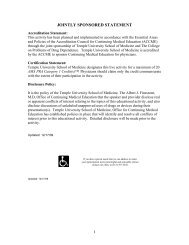
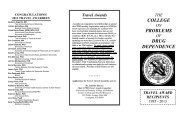
![2013SYMP AND WORKSHOP LIST[web]](https://img.yumpu.com/35325424/1/190x245/2013symp-and-workshop-listweb.jpg?quality=85)
